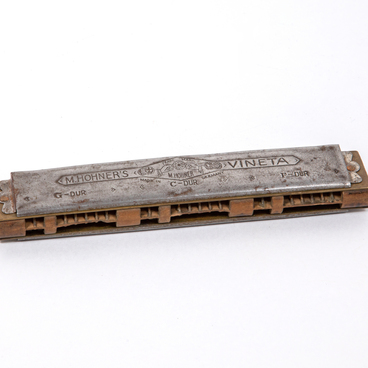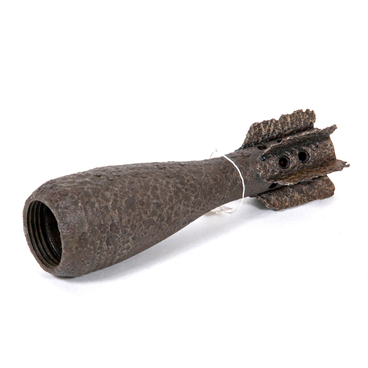The Feldflasche 31 kit — an aluminum flask in a felt case — was part of the official military equipment of the Wehrmacht soldiers during the Second World War. At that time, the cases were made of green and gray felt. Olive and feldgrau (the official basic color of German military uniforms) were considered the best colors for the flasks.
The case displayed in the museum was made of felt, which had a protective dark color, and was used as a small bag for a flask. The seam was secured with webbing along the edges. The felt case kept the water inside from freezing in winter. Furthermore, it could keep the water cold for a long time in summer, the case simply to be wetted.
There is a cut on the left side of the case which fastens with four metal snap fasteners. An image of a four-pointed star can be seen on them. By undoing the snap fasteners, the soldier could remove the flask to clean it or replace it with a new one.
Leather loops are attached to the front and back sides of the case; through them runs a black leather-fastening strap with a buckle. A screw cap made of aluminum is also attached to it. To prevent the flask from leaking, the cap has a brown rubber gasket. In addition, on the strap there is a shackle — a carabiner made of metal and painted in gray. Soldiers attached the flask to their bread bags or to a belt’s loop. They adjusted the belt length with a special buckle.
The German tactical gear was elaborate, functional and high quality at the beginning of the war. Many items were made of leather: belts, Sam Browne belts, ammunition pouches, holsters, harnesses, various sacks, knapsacks, and cases.
The quality of equipment remained high up until 1942; however, it noticeably declined by the end of the war. Flask cases were made of ordinary thick cotton cloth, and straps and loops were made of canvas or artificial leather. Black leather straps were supposed to be stitched with black threads according to the rules, but white threads were also used in 1944-1945.
The manufacturer’s ink mark was pressed on the inside, usually along the webbing. Sometimes leather or canvas straps were also labeled.
The case displayed in the museum was made of felt, which had a protective dark color, and was used as a small bag for a flask. The seam was secured with webbing along the edges. The felt case kept the water inside from freezing in winter. Furthermore, it could keep the water cold for a long time in summer, the case simply to be wetted.
There is a cut on the left side of the case which fastens with four metal snap fasteners. An image of a four-pointed star can be seen on them. By undoing the snap fasteners, the soldier could remove the flask to clean it or replace it with a new one.
Leather loops are attached to the front and back sides of the case; through them runs a black leather-fastening strap with a buckle. A screw cap made of aluminum is also attached to it. To prevent the flask from leaking, the cap has a brown rubber gasket. In addition, on the strap there is a shackle — a carabiner made of metal and painted in gray. Soldiers attached the flask to their bread bags or to a belt’s loop. They adjusted the belt length with a special buckle.
The German tactical gear was elaborate, functional and high quality at the beginning of the war. Many items were made of leather: belts, Sam Browne belts, ammunition pouches, holsters, harnesses, various sacks, knapsacks, and cases.
The quality of equipment remained high up until 1942; however, it noticeably declined by the end of the war. Flask cases were made of ordinary thick cotton cloth, and straps and loops were made of canvas or artificial leather. Black leather straps were supposed to be stitched with black threads according to the rules, but white threads were also used in 1944-1945.
The manufacturer’s ink mark was pressed on the inside, usually along the webbing. Sometimes leather or canvas straps were also labeled.

